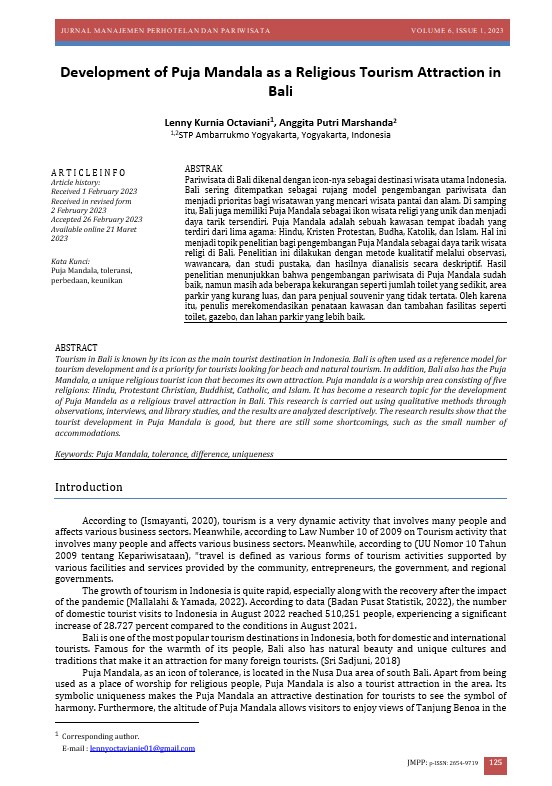Development of Puja Mandala as a Religious Tourism Attraction in Bali
DOI:
https://doi.org/10.23887/jmpp.v6i1.57994Keywords:
puja mandala, tolerance, difference, uniquenessAbstract
Tourism in Bali is known by its icon as the main tourist destination in Indonesia. Bali is often used as a reference model for tourism development and is a priority for tourists looking for beach and natural tourism. In addition, Bali also has the Puja Mandala, a unique religious tourist icon that becomes its own attraction. Puja mandala is a worship area consisting of five religions: Hindu, Protestant Christian, Buddhist, Catholic, and Islam. It has become a research topic for the development of Puja Mandela as a religious travel attraction in Bali. This research is carried out using qualitative methods through observations, interviews, and library studies, and the results are analyzed descriptively. The research results show that the tourist development in Puja Mandala is good, but there are still some shortcomings, such as the small number of accommodations.
References
Badan Pusat Statistik. (2022). Jumlah kunjungan wisman ke Indonesia melalui pintu masuk utama pada Agustus 2022 mencapai 510,25 ribu kunjungan dan Jumlah penumpang angkutan udara internasional pada Agustus 2022 naik 32,29 persen. http://surl.li/frgte
Chaerunissa, S. F., & Yuniningsih, T. (2020). Analisis komponen pengembangan pariwisata desa wisata Wonolopo Kota Semarang. Journal of Public Policy and Management Review, 9, 159–175.
Dinas Pariwisata. (2022, September 6). Banyaknya kunjungan wisatawan nusantara ke Bali. http://surl.li/frgtn
Fadli, M. R. (2021). Memahami desain metode penelitian kualitatif. HUMANIKA, 21(1), 33–54. https://doi.org/10.21831/hum.v21i1.38075
Firawan, I. G. N. F., & Suryawan, I. B. (2016). Potensi daya tarik wisata air terjun Nungnung sebagai daya tarik wisata alam. Jurnal Destinasi Pariwisata, 4(2), 92. https://doi.org/10.24843/JDEPAR.2016.v04.i02.p15
I Nyoman Darma Putra. (2017). Puja Mandala Nusa Dua: Monumen Bhineka Tunggal Ika Bali untuk Indonesia. Prosiding Seminar Nasional Kajian Muktahir Bahasa, Sastra, Dan Budaya Daerah untuk Membangun Kebhinekatunggalikaan Negara Kesatuan Republik Indonesia. 29–43. https://erepo.unud.ac.id/id/eprint/16484
Ismayanti. (2020). Dasar-dasar pariwisata. Jakarta: Universitas Sahid.
Mallalahi, N. H., & Yamada, K. (2022). Can a New Organization Mitigate Conflicts Among Multiple Institutions Managing a World Heritage Site? Case of Borobudur Tourism Authority Board. Jurnal Kepariwisataan Indonesia: Jurnal Penelitian Dan Pengembangan Kepariwisataan Indonesia, 16(2), 86–102. https://doi.org/10.47608/jki.v16i22022.86-102
Mancapara, I. G. P. (2018). Pluralisme di Puja Mandala Nusa Dua Bali sebagai destinasi pariwisata religi. Pariwisata Budaya: Jurnal PAriwisaya, Agama, dan Budaya Fakultas Dharma Duta, vol 3 nomor 1. https://doi.org/10.25078/pba.v3i1.423
Pramono*, M. F., & Hud, F. A. (2021). Puja Mandala in Benoa, Badung, Bali as the model of religious tolerance. Journal of Comparative Study of Religions, 1(2). https://doi.org/10.21111/jcsr.v1i2.6383
Sri Sadjuni, N. L. G. (2018). Persepsi wisatawan terhadap pantai Nusa Dua. Jurnal Ilmiah Hospitality Management, 4(2), 151–166. https://doi.org/10.22334/jihm.v4i2.62
UU Nomor 10 Tahun 2009 tentang kepariwisataan. (t.t.). Diambil 12 Februari 2023, dari https://jdih.kemenparekraf.go.id/katalog-1-produk-hukum










